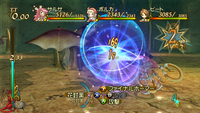|
|

|
PLATFORM
|
Xbox 360
|
BATTLE SYSTEM
|

|
INTERACTION
|

|
ORIGINALITY
|

|
STORY
|

|
MUSIC & SOUND
|

|
VISUALS
|

|
CHALLENGE
|
Fairly Easy
|
COMPLETION TIME
|
25-50 hours
|
|
OVERALL

|
Click here for scoring definitions
|
|
|
When it was announced that tri-Crescendo would be developing a role-playing title for the Xbox 360 under the supervision of Namco Bandai Games, skeptical is the word that came to mind. Indeed, after a slow start, it would seem that the game might live up to the wary thoughts that ran through many a mind during its development. The game in question was Eternal Sonata, or, as it is known in Japan, Trusty Bell: Chopin no Yume. The game had some lofty goals set forth in it: for the player to be immersed in the dream world of a comatose composer who lies on his deathbed.
What starts off as a simple story about the lives of many different people eventually intertwines itself with a deeper story about life and how everyone, the player included, should live out each day to the fullest. The story during the first half of the game revolves around two separate groups of characters as they each work on problems of their own. Eventually, these two groups come together and in the end decide to continue to travel as a single party. This companionship continues to grow throughout the story and eventually blossoms into an even deeper connection, even tying the player into the story.
The battle system of Eternal Sonata is a unique one in that at certain points during the story, players will unlock new battle levels, which increases the difficulty of the system, but also adds new abilities for use. This slowly allows players to get accustomed to the new features that unlock each time, and before too long it is not even noticeable that there was a change. In all, there are six different battle levels, though the final one is only unlocked in a bonus dungeon. The most unique change in the system occurs in this final battle upgrade, however, as during the use of harmony chains, players will have to keep an eye on the button configuration listed on screen as it changes after each one. The configuration changes go back to normal after each battle, but it adds a new step to the battle system that will keep players on their toes without making the battling any harder than it currently is.
 Shiny wings.
Shiny wings.
|
|
Light and dark areas on the battle field play a huge role in the game's battle system. There are different special attacks for each and some enemies morph into different creatures when moving between light and dark areas. Don't take the battlefield for granted, though, as sometimes the areas will change. An example of this is an outdoor battle taking place in a sunny field, when suddenly a cloud floats over the battlefield, creating a moving dark area. Having special attacks setup correctly will sometimes play a big part in creating an advantage for the player to use during a regular or even a boss battle. There are some weapons for characters that have light and dark attack power, so players will need to keep an eye on that and also enemy weaknesses, as certain enemies have varying defense against light and dark attacks.
As players level up, they will find that any characters not in their current party will also receive some experience, albeit slightly less, and will continue to level up. These bench characters will become important later on in the game and many players will find themselves setting up different groups of characters for use in different situations. Each character has unique abilities and players must utilize these well in battle to take advantage of enemies. The biggest advantage that players will find is that sneaking up on enemies from behind will generally net them more turns before the enemy gets a chance to attack, giving them the opportunity to take enemies out quickly and efficiently.
Many components of the game are musically themed, from collecting score pieces to composing music with random NPCs or just in the character and area names. Characters range from Polka to Salsa, with towns having uniquely musical names such as Ritardando and Tenuto. Due to this, one would expect that the developers would ensure that the game had quite the musical score to go along with the game's many different takes on music itself. The main soundtrack of the game was handled by Motoi Sakuraba and all the music fit their situations very well, really helping the player to feel the emotions evoked by the scenes. The game also includes a select few pieces from Chopin, with the pieces being played by Russian pianist Stanislav Bunin. Sound effects in the game also seemed to be well thought out and appropriate for the situations.
 Yarrrrr
Yarrrrr
|
|
Sadly the game is pretty linear when it comes to the storyline and exploration, though there are still a number of sidequests that players will find. For players to be able complete all 22 of the game's Xbox Live achievements, they will need to playthrough the game at least twice, more if they miss anything. Though a few of the achievements can be earned just by playing through the game, there are a number of them that reward those players that enjoy exploring and also for completing the bonus content, such as the extra dungeon. While this does add a decent amount of time to the game clock, the bonus dungeon doesn't pose much of a difficulty by the time it is reached. For those interested in playing through the game again, the developers do try and make things more of a challenge by making enemies tougher to battle. There are also new scenes to be found for people wary that playing through the game again won't offer anything new in terms of story.
This game definitely takes a step forward when it comes to the graphics department with very colorful, animated areas. Enemies can be seen mulling around large openings when in the field and meandering slowly through dank, dark dungeons. Unfortunately, players can't marvel at the entire area due to the static camera that sometimes gets in the way of movement. However, many areas are pretty wide open for the player to explore, with flowing grass and trees waving in the backgrounds. Water, especially when sitting still, is a marvel to look at, though it is a tad disappointing that in areas where the characters can walk through water, there are sound effects for it but no visual rippling. Light reflects off of the water's surface and is broken by waves, moving as the characters wander by to reflect the way light on water looks in real life. Mirrors give off real-time reflections when players run past, including whatever is in the background. The only real disappointing part of the game's beautiful world is that players aren't really able to explore and get a better look at it.
This game can be very easy the first time through, though players will need to be careful as if they don't pay close enough attention, the tide of war can quickly sway in the enemy's favor. Players will need to use the ability to sneak up on enemies as well as the light and dark weaknesses they possess against them. In the end, while the game isn't overly hard or completely original, the game does one thing quite well: it's fun. Being able to learn about history and musical composers has never been quite this fun, and players will be able to listen to music they hear in the game through the menu, which allows for both Sakuraba's and Chopin's music to be heard at any time. In the end, whether or not the world was Chopin's dream world or not isn't really that important, it's that all these characters learned that, to them, life is what you put into it.
Review Archives
|









